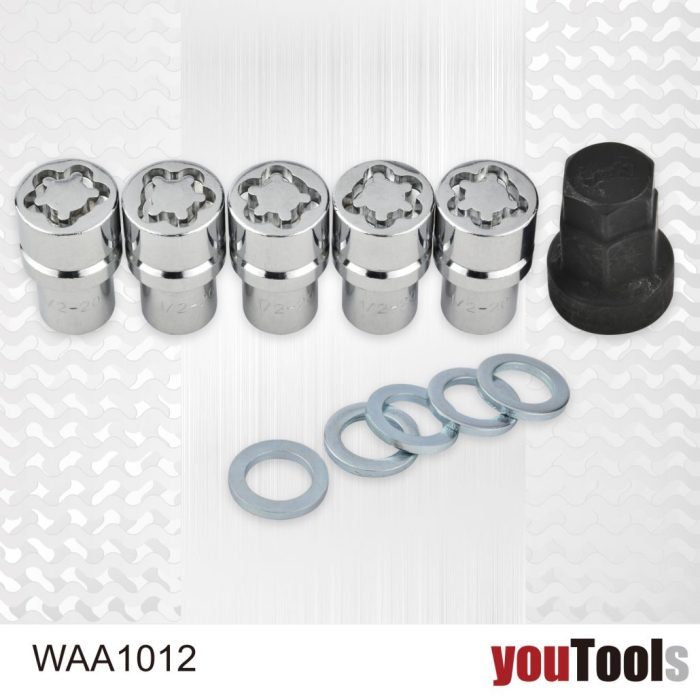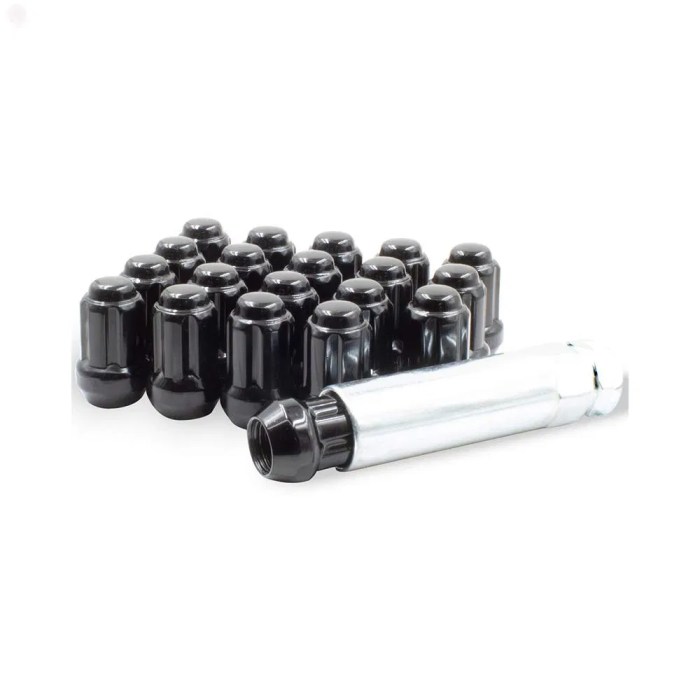Anti-theft lug nuts for alloy wheels: Seriously, who wants their rims jacked? These aren’t your grandpa’s lug nuts; we’re talking about serious security for your sweet ride. From super-tough materials to clever designs that would make a locksmith jealous, there’s a whole world of anti-theft options out there. This guide breaks down everything you need to know to keep your wheels where they belong – on your car.
We’ll cover the different types, how they work, how to install them, and even what to do if you lose the key (don’t worry, it happens!). Choosing the right anti-theft lug nuts is about more than just looking cool; it’s about protecting your investment. Let’s dive in!
Product Overview

So, you’re looking to beef up your wheel security? Smart move. Alloy wheels are pricey, and no one wants to deal with the hassle of theft. Anti-theft lug nuts are your low-key, highly effective solution. They’re designed to make removing your wheels a serious pain for would-be thieves, significantly reducing the risk of theft.
Let’s dive into the different types and what makes them tick.
Types of Anti-Theft Lug Nuts
Anti-theft lug nuts come in a variety of designs, each with its own strengths and weaknesses. The core idea is to create a nut that requires a special key for removal, preventing standard tools from working. The most common materials are hardened steel and sometimes even hardened alloys, offering superior resistance to drilling or other forceful removal attempts.
Anti-Theft Lug Nut Systems Comparison
Choosing the right system depends on your budget and desired security level. Here’s a breakdown:
| Type | Material | Security Level | Price Range |
|---|---|---|---|
| Standard keyed lug nuts | Steel | Medium | $20-$50 |
| Locking lug nuts with a unique key pattern | Steel or hardened alloy steel | High | $40-$80 |
| Lug nuts with a tamper-resistant design (e.g., spline drive) | Hardened steel | Very High | $60-$120 |
| Electronic locking lug nuts (with integrated sensors) | Steel, with electronic components | Very High | $100+ |
Note: Price ranges are approximate and can vary based on brand, quantity, and retailer.
Anti-theft Lug Nut Installation
Installing anti-theft lug nuts is generally straightforward, but it’s crucial to follow the instructions carefully. For most standard keyed systems, you’ll only need a wrench that fits your specific key. However, some systems, especially those with more complex designs, might require specialized tools. For example, spline drive lug nuts need a special socket designed to match their unique pattern.
Seriously considering anti-theft lug nuts for my alloy wheels after hearing about so many wheel thefts lately. If someone does manage to snag my wheels, though, I’ll know exactly what to do; I’ve bookmarked the instructions on How to file a claim with USAA just in case. Hopefully, those lug nuts will do their job and I won’t need it, but it’s better to be prepared!
Electronic systems may require additional steps for pairing and programming. Always consult the manufacturer’s instructions for detailed guidance. Remember, it’s a good idea to keep your key(s) in a safe place, away from the vehicle itself. Losing your key means you’ll need to replace the entire set.
Security Features and Effectiveness
Anti-theft lug nuts are designed to deter opportunistic thieves and make stealing your wheels a significantly more challenging—and time-consuming—endeavor. Their effectiveness hinges on a combination of robust design features and the inconvenience they create for would-be wheel thieves. The more intricate the design and the more specialized the tools required, the greater the security offered.Different anti-theft lug nut designs employ various security mechanisms.
These mechanisms aim to frustrate common theft methods like using standard lug wrenches or easily accessible tools. The level of security offered varies greatly depending on the brand, model, and the specific features incorporated.
Security Mechanisms in Anti-theft Lug Nut Designs
Several key mechanisms contribute to the effectiveness of anti-theft lug nuts. These include unique key patterns, hardened steel construction, and tamper-resistant designs. Many designs incorporate a keyed system, where a special key is required to remove the nuts. This key has a unique profile that prevents standard lug wrenches from working. The nuts themselves are often made of hardened steel, making them much more resistant to damage or stripping than standard nuts.
Some designs incorporate a locking mechanism that prevents the nut from turning unless the correct key is used. Others might use a pin or other internal component that blocks removal without the special tool.
Comparison of Security Levels Across Brands and Models
Choosing the right anti-theft lug nuts involves understanding the varying levels of security offered by different brands and models. While a definitive ranking is difficult due to evolving designs and limited public testing data, a general comparison can be made based on common features and user reviews.
- High Security: Brands that often receive high praise for their security typically incorporate multiple mechanisms, such as unique key patterns, hardened steel construction, and potentially patented locking mechanisms. These often come with multiple keys and robust packaging to prevent tampering or counterfeiting. They might also offer a replacement key service in case of loss.
- Medium Security: These lug nuts usually feature a unique key pattern and hardened steel construction, but may lack some of the more advanced locking mechanisms found in high-security options. They represent a good balance between cost and security.
- Lower Security: These are often simpler designs with a less intricate key pattern and potentially less robust materials. While they offer some level of deterrence, they are generally more susceptible to theft than higher-security options. These are usually more affordable, but that comes with a corresponding tradeoff in security.
Note that even the most secure anti-theft lug nuts are not completely theft-proof. Determined thieves with specialized tools can still potentially remove them, although this increases the time and effort significantly, making the theft less likely.
So, you’re thinking about those anti-theft lug nuts for your sweet alloy wheels? Smart move, protecting your rims is key. But have you considered the bigger picture? If your business relies on those wheels, you’ll want solid Commercial auto insurance for small businesses to cover potential damage or theft. After all, replacing those fancy rims and the lug nuts isn’t cheap, so comprehensive coverage is a must-have.
Hypothetical Theft Scenarios
Let’s imagine two scenarios using a high-security McGard brand anti-theft lug nut set. Scenario 1: Successful Theft Attempt (Highly Unlikely)A highly skilled thief with specialized tools, such as a custom-made lug wrench designed to mimic the McGard key profile, or a powerful impact wrench, could potentially overcome the security features. They would need the right tools and a fair amount of time and expertise to succeed.
This would likely involve causing significant damage to the wheels or lug nuts in the process. Scenario 2: Unsuccessful Theft Attempt (More Likely)A common thief attempts to steal the wheels using a standard lug wrench. The unique key pattern of the McGard lug nuts prevents the wrench from engaging properly. The thief becomes frustrated, unable to remove the wheels, and abandons the attempt.
The McGard nuts remain securely in place, protecting the wheels.
Compatibility and Selection

Choosing the right anti-theft lug nuts is crucial for both security and the longevity of your wheels. A proper fit prevents damage to your wheels and ensures the nuts effectively deter theft. Incorrect selection can lead to stripped threads, damaged wheels, or even compromised security. Let’s break down how to make the best choice.Selecting the correct anti-theft lug nuts involves considering several key factors: your wheel type, your vehicle’s make and model, and your desired level of security.
These factors are interconnected, and a mismatch can lead to significant problems. For instance, using lug nuts that are too short can prevent the wheel from properly seating, while those that are too long can interfere with the brake caliper or suspension components. Paying attention to detail is key.
Wheel Type Identification
Knowing your wheel type—whether it’s steel or alloy—is fundamental. Alloy wheels often have a more delicate design, and using incompatible lug nuts can easily damage them. Steel wheels, being more robust, generally offer more tolerance for variations. The lug nut seat type (cone, ball, or mag) is also crucial. The seat is the surface of the lug nut that contacts the wheel.
An incorrect seat type can cause damage to both the wheel and the lug nut. For example, a cone-seat lug nut used on a ball-seat wheel will create a point of high stress that can damage the wheel.
Vehicle Make, Model, and Year
Different vehicles have different lug nut specifications. These specifications include the thread size (e.g., M12 x 1.5), the lug nut length, and the seat type. These details are usually found in your owner’s manual or on a sticker located on the driver’s side doorjamb. Using the incorrect thread size can lead to stripped threads and the inability to properly secure your wheels.
Failing to account for the lug nut length can cause interference with brake components or prevent the wheel from seating properly.
Desired Security Level
Anti-theft lug nuts are available in varying security levels. Some offer basic protection, while others employ more advanced designs like locking keys with unique patterns. Consider the level of risk in your area. Higher-risk areas may necessitate more robust anti-theft solutions. For example, a simple locking key mechanism may suffice in a low-crime area, whereas a more sophisticated system with multiple locking points might be necessary in a high-theft area.
Examples of Wheel Configurations and Lug Nut Options
It’s important to understand the variety of wheel and lug nut combinations. Choosing the wrong type can have serious consequences. Here are a few examples:
- Standard Steel Wheels: These often accept standard lug nuts with a cone or ball seat. Basic anti-theft lug nuts with a simple locking key are generally sufficient.
- High-Performance Alloy Wheels: These often require lug nuts with specific seat types and lengths to avoid damage. More secure anti-theft lug nuts with tamper-resistant designs are recommended.
- Aftermarket Wheels: Always check the manufacturer’s specifications for your aftermarket wheels to determine the correct lug nut size, thread pitch, and seat type. Using the wrong lug nuts can void warranties and potentially damage the wheels. High-security anti-theft lug nuts are recommended due to the increased value of these wheels.
Always consult your vehicle’s owner’s manual for the correct lug nut specifications before purchasing anti-theft lug nuts.
Maintenance and Replacement
Keeping your anti-theft lug nuts in top shape isn’t rocket science, but a little TLC goes a long way in ensuring they continue to protect your wheels. Regular maintenance prevents issues and keeps your investment secure. Neglecting this can lead to problems down the road, compromising the very security they’re designed to provide.Proper care and maintenance of your anti-theft lug nuts involves a straightforward process that will extend their lifespan and effectiveness.
Think of it as preventative maintenance for your wheels’ security system.
Cleaning and Lubrication
Regular cleaning removes dirt, grime, and road salt that can corrode the nuts and their locking mechanisms. A simple cleaning with a wire brush and degreaser, followed by a light application of anti-seize lubricant to the threads, will significantly improve the longevity and performance of your anti-theft system. This lubrication helps prevent seizing and ensures smooth removal and installation.
Avoid using excessive lubricant, as this could interfere with the locking mechanism.
Replacing a Lost or Damaged Anti-theft Lug Nut
Losing or damaging an anti-theft lug nut is a frustrating, but thankfully solvable, problem. The first step is to locate your spare key or the special tool that came with your anti-theft lug nut set. These are usually stored in a safe place, perhaps with your vehicle’s paperwork or in the glove compartment. If you can’t find it, contact the manufacturer or retailer where you purchased the lug nuts.
They may be able to provide a replacement key or tool, possibly after verifying ownership. If the nut itself is damaged beyond repair, you’ll need to replace the entire set for optimal security, as replacing just one compromises the integrity of the system. Always purchase replacement lug nuts from a reputable source to ensure compatibility and quality.
Potential Issues from Neglecting Maintenance
Ignoring the maintenance of your anti-theft lug nuts can lead to several issues. Corrosion from road salt and grime can cause the nuts to seize, making them extremely difficult, if not impossible, to remove without damaging the wheel or the nut itself. This could strand you if you need a tire change. Furthermore, a compromised locking mechanism, due to lack of lubrication or corrosion, significantly reduces the effectiveness of the anti-theft system, leaving your wheels vulnerable to theft.
In extreme cases, a seized or damaged nut could even lead to wheel detachment while driving, resulting in a dangerous and potentially costly situation. Regular maintenance is a small investment to prevent these far more significant problems.
Cost and Value: Anti-theft Lug Nuts For Alloy Wheels
Investing in anti-theft lug nuts might seem like a small expense, but when you consider the potential cost of replacing stolen wheels, it quickly becomes a smart financial decision. This section will break down the cost comparison and demonstrate the long-term value proposition of securing your investment.
The price of anti-theft lug nuts varies greatly depending on the brand, material, and security features. Generally, you can expect to pay anywhere from $30 to $150 or more for a complete set. This might seem steep initially, but let’s compare this to the potential cost of wheel theft.
Anti-theft Lug Nut System Cost Comparison
The following table illustrates the price range of various anti-theft lug nut systems and contrasts them with the potential cost of wheel replacement. Remember, these are estimates and actual costs will vary based on your vehicle, wheel type, and location.
| System Type | Estimated Cost | Potential Wheel Replacement Cost (per wheel) | Potential Total Wheel Replacement Cost (4 wheels) |
|---|---|---|---|
| Basic Locking Lug Nuts | $30 – $50 | $100 – $300 | $400 – $1200 |
| Mid-Range System with Keyed Socket | $60 – $100 | $100 – $300 | $400 – $1200 |
| High-Security System with Patented Design | $100 – $150+ | $100 – $300 | $400 – $1200 |
Long-Term Value Proposition, Anti-theft lug nuts for alloy wheels
While the initial investment in high-quality anti-theft lug nuts might seem significant, the long-term value is undeniable. Consider the scenario of a wheel theft. Replacing a single stolen wheel can cost hundreds of dollars, not including labor and any potential damage to your vehicle during the theft. A high-quality anti-theft system acts as a preventative measure, significantly reducing this risk and saving you potentially thousands of dollars over the lifespan of your vehicle.
The peace of mind alone is invaluable.
Return on Investment
Let’s illustrate the potential return on investment (ROI) with a simple example. Suppose you invest $100 in a high-security anti-theft lug nut system. If you prevent the theft of even one wheel valued at $300 (including labor costs to replace), you’ve already achieved a 300% ROI. The prevention of the theft of all four wheels would yield an even more substantial return.
This clearly demonstrates that the cost of anti-theft lug nuts is a small price to pay for the significant protection they provide.
Customer Reviews and Feedback
Customer reviews offer invaluable insights into the real-world performance and user experience of anti-theft lug nuts. Analyzing this feedback helps potential buyers make informed decisions and manufacturers improve their products. By examining common themes and issues, we can better understand the strengths and weaknesses of different brands and models.
Understanding customer reviews is crucial for choosing the right anti-theft lug nuts. Positive reviews often highlight ease of installation, robust security, and compatibility with various wheel types. Negative reviews, on the other hand, may point to issues such as difficulty in removal, susceptibility to theft, or poor quality materials. This information directly influences purchase decisions.
Summary of Common Customer Reviews
Customer reviews across various e-commerce platforms and automotive forums reveal several recurring themes. These reviews span a range of anti-theft lug nut brands and models, allowing for a comprehensive overview of user experiences.
- Positive Feedback: Many users praise the robust security offered by high-quality anti-theft lug nuts, citing successful deterrence of theft attempts. Ease of installation with the provided key is also frequently mentioned, as is the durability of the materials used in construction. Some brands receive praise for their clear instructions and helpful customer service.
- Negative Feedback: Common complaints include difficulty removing the lug nuts, even with the correct key, often attributed to seizing due to corrosion or poor design. Some users report instances of theft despite using anti-theft lug nuts, suggesting vulnerabilities in certain designs or improper installation. Issues with key durability and breakage are also reported, along with concerns about compatibility with certain wheel types or aftermarket lug nut tools.
- Brand-Specific Feedback: While individual experiences vary, certain brands consistently receive more positive or negative reviews than others. For example, some brands are praised for their superior key design and material, while others are criticized for their susceptibility to stripping or corrosion. This highlights the importance of researching specific brands before purchasing.
Recurring Themes and Issues
Several key issues consistently emerge from customer reviews. These issues highlight areas where manufacturers can improve their designs and where consumers should exercise caution.
- Corrosion and Seizing: Many reviews mention difficulties removing lug nuts due to corrosion, particularly in areas with harsh weather conditions. This suggests the need for anti-corrosion coatings or materials more resistant to rust and seizing.
- Key Durability: Breakage or wear of the removal key is a common complaint. This emphasizes the importance of using high-quality materials and robust designs for the key itself.
- Compatibility Issues: Some reviews highlight incompatibility with certain wheel types or aftermarket tools. Clear and accurate compatibility information is essential to avoid these problems.
- Security Concerns: Although anti-theft lug nuts are designed to deter theft, some users report successful theft attempts. This indicates the need for ongoing innovation in anti-theft design to stay ahead of potential thieves’ methods.
How Customer Feedback Informs Selection
Customer feedback is instrumental in making informed decisions when choosing anti-theft lug nuts. By carefully considering the common themes and issues highlighted in reviews, potential buyers can significantly reduce the risk of purchasing a subpar product.
- Prioritize Reviews Focusing on Durability and Ease of Use: Look for reviews emphasizing the longevity of the lug nuts and the ease of installation and removal with the provided key. Negative reviews regarding corrosion or key breakage should be taken seriously.
- Research Brand Reputation: Pay attention to brands that consistently receive positive reviews for their security features, durability, and customer service. Avoid brands with numerous negative reviews concerning key breakage or security vulnerabilities.
- Check for Compatibility: Before purchasing, verify compatibility with your specific vehicle’s wheel type and lug nut size. Reviews often highlight compatibility issues, so this information is invaluable.
- Consider the Climate: If you live in an area with harsh weather conditions, prioritize lug nuts with anti-corrosion coatings or materials known for their resistance to rust and seizing.
Final Summary
Protecting your alloy wheels from theft doesn’t have to be a headache. By understanding the various types of anti-theft lug nuts, their security features, and proper installation, you can significantly reduce the risk of wheel theft. Remember to consider factors like compatibility, maintenance, and long-term value when making your decision. Investing in a solid set of anti-theft lug nuts is a small price to pay for the peace of mind knowing your wheels are safe and sound.
So, ditch the worries and upgrade your wheel security today!









